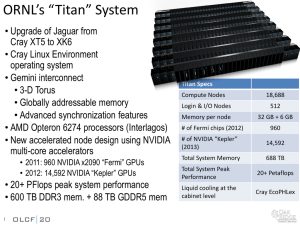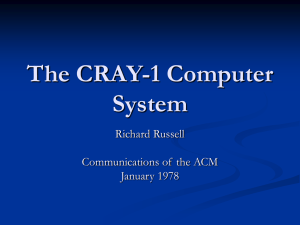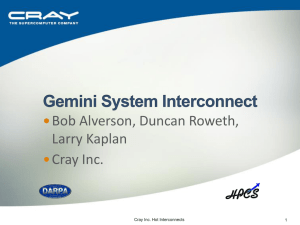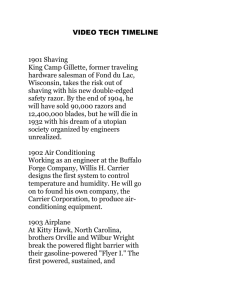The Cray Supercomputers - Edward Bosworth, Ph.D.
advertisement
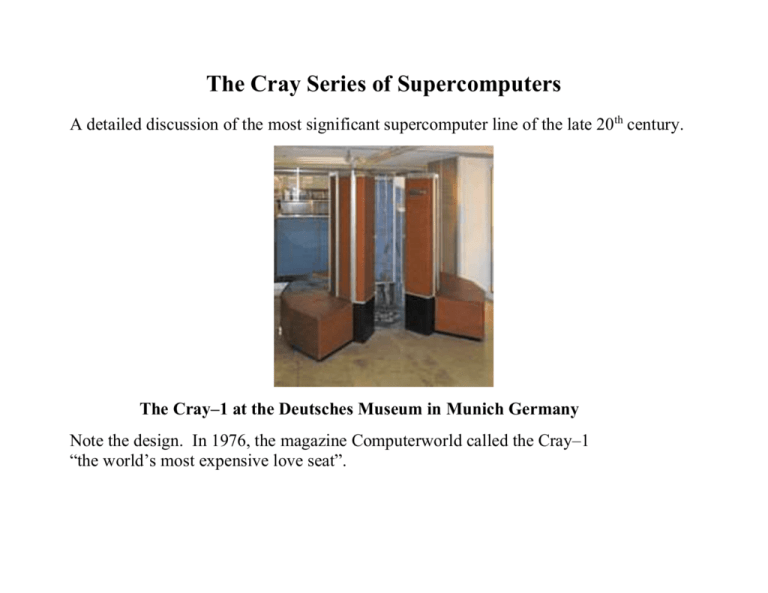
The Cray Series of Supercomputers A detailed discussion of the most significant supercomputer line of the late 20th century. The Cray–1 at the Deutsches Museum in Munich Germany Note the design. In 1976, the magazine Computerworld called the Cray–1 “the world’s most expensive love seat”. History of Seymour Cray and His Companies In order to understand the Cray line of computers, we must look at the personal history of Seymour Cray, the “father of the supercomputer”. Cray began work at Control Data Corporation soon after its founding in 1960 and remained there until 1972. He designed several computers, including the CDC 1604, CDC 6600, and CDC 7600. The CDC 1604 was intended just to be a good computer; all computers beginning with the CDC 6600 were designed for speed. The CDC 6600 is often called the first RISC (Reduced Instruction Set Computer), due to the simplicity of its instruction set. The reason for its simplicity was the desire for speed. Cray also put a lot of effort into matching the memory and I/O speed with the CPU speed. As he later noted, “Anyone can build a fast CPU. The trick is to build a fast system.” The CDC 6600 lead to the more successful CDC 7600. Full disclosure: I have programmed on the CDC 6600, CDC 7600, and Cray–1; I found each to be excellent. The CDC 8600 was to be a follow–on to the CDC 7600. While an excellent design, it proved too complex to manufacture successfully, and was abandoned. Cray left Control Data Corporation in 1972 to found Cray Research, based in Chippewa Falls, Wisconsin. The first Cray–1 was delivered in 1976. Seymour Cray: Continued In 1989, Cray left the company in order to found Cray Computers, Inc. His reason for leaving was that he wanted to spend more time on research, rather than just churning out the very profitable computers that his previous company was manufacturing. This lead to an interesting name game: Cray Research, Inc. producing a large number of commercial computers Cray Computer, Inc. mostly invested in research on future machines. The Cray–3, a 16–processor system, was announced in 1993 but never delivered. The Cray–4, a smaller version of the Cray–3 with a 1 GHz clock was ended when the Cray Computer Corporation went bankrupt in 1995. Seymour Cray died on October 5, 1996. In 1993, Cray Research moved away from pure vector processors, producing its first massively parallel processing (MPP) system, the Cray T3D™. Cray Research merged with SGI (Silicon Graphics, Inc.) in February 1996. It was spun off as a separate business unit in August 1999. In March 2000, Cray Research was merged with Terra Computer Company to form Cray, Inc. Cray–1: The Physical Machine Here is a schematic of the Cray–1. At the base, it is more than 8 feet in diameter. We may think this a large computer, but for its time the Cray–1 was surprisingly small. Processor Specifications of the Cray–1 Source: Cray–1 Computer System Hardware Reference Manual Publication 2240004, Revision C, November, 1977. Memory Specifications of the Cray–1 Note that the memory size, without error correction, would be 8MB. Each word has 64 data bits (8 bytes) as well as 8 bits for error correction. Other material indicates that the memory was low–order interleaved. Source: Cray–1 Computer System Hardware Reference Manual Publication 2240004, Revision C, November, 1977. The Cray–1 Vector Registers It is important to understand the structure and function of the vector registers. Each of the vector registers is a vector of registers, best viewed as a collection of sixty–four registers each holding 64 bits. A vector register held 4,096 bits. Vector registers are loaded from primary memory and store results back to primary memory. One common use would be to load a vector register from sixty–four consecutive memory words. Nonconsecutive words could be handled if they appeared in a regular pattern, such as every other word or every fourth word, etc. One might consider each register as an array, but that does not reflect its use. The Cray–1 Vector and Scalar Registers One of the key design features of the Cray is the placement of a large number of registers between the memory and the CPU units. These function much as cache memory. Note that the scalar and address registers also have auxiliary registers. Cache Memory on the Cray Here we pay special attention to the Scalar Registers and the Address Registers. All of the registers, including the vector registers, are implemented in static memory with six nanosecond access time. The main memory has 50 nanosecond access time. The Cray–1 does not have explicit cache memory, but note the two pairs of register sets. The eight scalar registers backed up by the sixty–three temporary registers. The eight address registers backed up by the sixty–three auxiliary address registers. In some sense, we can say that 1. the T registers function as a cache for the S registers, and 2. the B registers function as a cache for the A registers. “Without the register storage provided by the B, T, and V registers, the CRAY–1’s [memory] bandwidth of only 80 million words per second would be a serious impediment to performance.” [R. M. Russell, 1978] Each word is 8 bytes; 80 million words per second is 640 million bytes per second, or one byte every 1.6 nanoseconds. Evolution of the Cray–1 In this course, the main significance of the CDC 6600 and CDC 7600 computers lies in their influence on the design of the Cray–1 and other computers in the series. Remember that Seymour Cray was the principle designer of all three computers. Here is a comparison of the CDC 7600 and the Cray–1. Item Circuit Elements Memory Scalar (word) size Vector Registers Scalar Registers Scalar Buffer Registers CDC 7600 Discrete Components Magnetic Core 60 bits None Eight: X0 – X7 None Address Registers Eight: A0 – A7 Address Buffer Registers None Two main changes: Cray–1 Integrated Circuitry Semiconductor (50 nanoseconds) 64 bits (plus 8 ECC bits) Eight, each holding 64 scalars. Eight: S0 – S7 Sixty–four T0 – T77 Octal numbering was used. Eight: A0 – A7 Sixty–four: B0 – B77 1. Addition of the eight vector registers. 2. Addition of fast buffer registers for the A and S registers. Chaining in the Cray–1 Here is how the technique is described in the 1978 article. “Through a technique called ‘chaining’, the CRAY–1 vector functional units, in combination with scalar and vector registers, generate interim results and use them again immediately without additional memory references, which slow down the computational process in other contemporary computer systems.” This is exactly the technique that we called “forwarding” when we discussed the pipelined datapaths. Consider the following example using the vector multiply and vector addition operators. MULTV V1, V2, V3 // V1[K] = V2[K] V3[K] ADDV // V4[K] = V1[K] + V5[K] V4, V1, V5 Without chaining (forwarding), the vector multiplication operation would have to finish before the vector addition could begin. Chaining allows a vector operation to start as soon as the individual elements of its vector source become available. The only restriction is that operations being chained belong to distinct functional units, as each functional unit can do only one thing at a time. Vector Startup Times Vector processing involves two basic steps: startup of the vector unit and pipelined operation. As in other pipelined designs, the maximum rate at which the vector unit executes instructions is called the “Initiation Rate”, the rate at which new vector operations are initiated when the vector unit is running at “full speed”. The initiation rate is often expressed as a time, so that a vector unit that operated at 100 million operations per second would have an initiation rate of 10 nanoseconds. I know: rates are not times. This is just the common terminology. The time to process a vector depends on the length of the vector. For a vector with length N (containing N elements) we have T(N) = Start–Up_Time + NInitiation_Rate The time per result is then T = (Start–Up Time) / N + Initiation_Rate. For short vectors (small values of N), this time may exceed the initiation rate of the scalar execution unit. An important measure of the balance of the design is the vector size at which the vector unit can process faster than the scalar unit. For a Cray–1, this crossover size was between 2 and 4; 2 N 4. For N > 4, the vector unit was always faster. Experimental Results: Scalar/Vector Timing Here are some comparative data for mathematical operations (Log, cosine, square root, and exponential), showing the per–result times as a function of vector length. Note the low crossover point, for vectors larger than N = 5, the vector unit is much faster. The time cost is given in clock ticks, not nanoseconds. See Russell, 1978. The Cray X–MP and Cray Y–MP The fundamental tension at Cray Research, Inc. was between Seymour Cray’s desire to develop new and more powerful computers and the need to keep the cash flow going. Seymour Cray realized the need for a cash flow at the start. As a result, he decided not to pursue his ideas based on the CDC 8600 design and chose to develop a less aggressive machine. The result was the Cray–1, which was still a remarkable machine. With its cash flow insured, the company then organized its efforts into two lines of work. 1. Research and development on the CDC 8600 follow–on, to be called the Cray–2. 2. Production of a line of computers that were derivatives of the Cray–1 with improved technologies. These were called the X–MP, Y–MP, etc. The X–MP was introduced in 1982. It was a dual–processor computer with a 9.5 nanosecond (105 MHz) clock and 16 to 128 megawords of static RAM main memory. A four–processor model was introduced in 1984 with a 8.5 nanosecond clock. The Y–MP was introduced in 1988, with up to eight processors that used VLSI chips. It had a 32–bit address space, with up to 64 megawords of static RAM main memory. The Y–MP M90, introduced in 1992, was a large–memory variant of the Y–MP that replaced the static RAM memory with up to 4 gigawords of DRAM. The Cray–2 While his assistant, Steve Chen, oversaw the production of the commercially successful X–MP and Y–MP series, Seymour Cray pursued his development of the Cray–2, a design based on the CDC 8600, which Cray had started while at the Control Data Corporation. The original intent was to build the VLSI chips from gallium arsenide (GaAs), which would allow must faster circuitry. The technology for manufacturing GaAs chips was not then mature enough to be useful as circuit elements in a large computer. The Cray–2 was a four–processor computer that had 64 to 512 megawords of 128–way interleaved DRAM memory. The computer was built very small in order to be very fast, as a result the circuit boards were built as very compact stacked cards. Due to the card density, it was not possible to use air cooling. The entire system was immersed in a tank of Fluorinert™, an inert liquid intended to be a blood substitute. When introduced in 1985, the Cray–2 was not significantly faster than the Y–MP. It sold only thirty copies, all to customers needing its large main memory capacity. The Cray–3 and the End of an Era After the Cray–2, Seymour Cray began another very aggressive design: the Cray–3. This was to be a very small computer that fit into a cube one foot on a side. Such a design would require retention of the Fluorinert cooling system. It would also be very difficult to manufacture as it would require robotic assembly and precision welding. It would also have been very difficult to test, as there was no direct access to the internal parts of the machine. The Cray–3 had a 2 nanosecond cycle time (500 MHz). A single processor machine would have a performance of 948 megaflops; the 16–processor model would have operated at 15.2 gigaflops. The 16–unit model was never built. The Cray–3 was delivered in 1993. In 1994, Cray Research, Inc. released the T90 with a 2.2 nanosecond clock time and eight times the performance of the Cray–3. In the end, the development of traditional supercomputers ran into several problems. 1. The end of the cold war reduced the pressing need for massive computing facilities. 2. The rise of microprocessor technology allowing much faster and cheaper processors. 3. The rise of VLSI technology, making multiple processor systems more feasible. Supercomputers vs. Multiprocessor Clusters “If you were plowing a field, which would you rather use: Two strong oxen or 1024 chickens”. Seymour Cray Although Seymour Cray said it more colorfully, there were many objections to the transition from the traditional vector supercomputer (with a few processors) to the massively parallel computing that replaced it. This slide quotes from an overview article written in 1984. It assessed the commercial viability of traditional vector processors and multiprocessor systems. The key issue in assessing the commercial viability of a multiple–processor system is the speedup factor; how much faster is a processor with N processors. Here are two opinions from the 1984 IEEE tutorial on supercomputers. “The speedup factor of using an n–processor system over a uniprocessor system has been theoretically estimated to be within the range (log2n, n/log2n). For example, the speedup range is less than 6.9 for n = 16. Most of today’s commercial multiprocessors have only 2 to 4 processors in a system.” “By the late 1980s, we may expect systems of 8–16 processors. Unless the technology changes drastically, we will not anticipate massive multiprocessor systems until the 90s.” As we shall see soon, technology has changed drastically. The Cray XT–5 Here is a picture of the Cray XT–5, one of the later and faster products from Cray, Inc. It is a MPP (Massively Parallel Processor) system, launched in November 2007. This is built from a number of Quad–Core AMD Opteron™ processor cores. The Operating System is a variant of Linux. References: Wikipedia: http://en.wikipedia.org/wiki/Cray-1 http://en.wikipedia.org/wiki/Cray_X-MP The History of Computing Project http://www.thocp.net/hardware/cray_1.htm Cray, Inc. http://www.cray.com/ R. M. Russell, “The Cray–1 computer system.”, Communications of the ACM, 21(1):63–72, 1978. Kai Hwang, “Evolution of Modern Supercomputers”, the introduction to Chapter 1 in the IEEE Tutorial Supercomputers: Design and Applications, 1984. ISBN 0 – 8186 – 0581 – 2.
